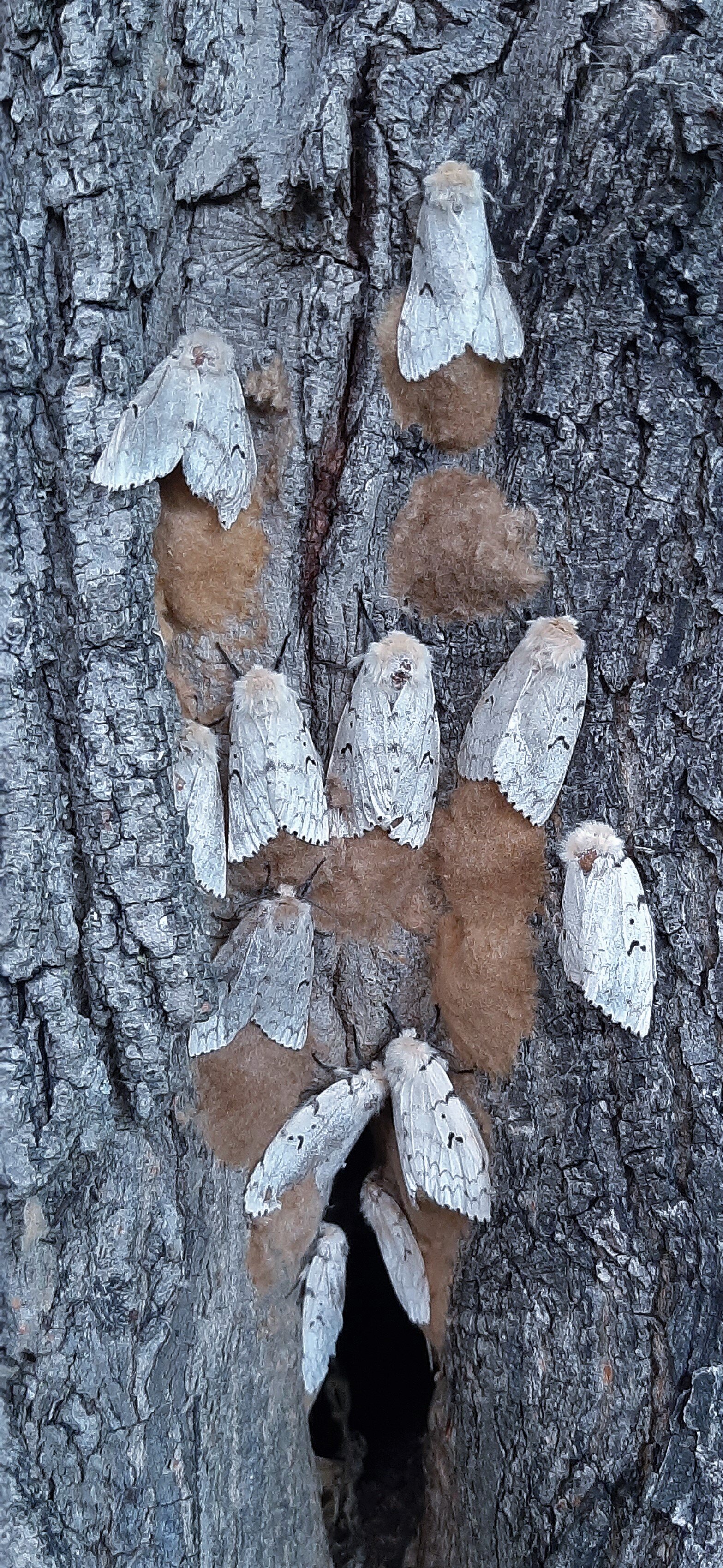Gypsy Moths
Gypsy moths caused a large amount of damage to trees in our region in the spring and summer of 2020. Many trees were devastatingly defoliated by hungry gypsy moth caterpillars. You may have first noticed small black hard bits underfoot on paths and docks. I wondered what it was. It turns out it was the gypsy moth caterpillars’ droppings called frass. Some people actually heard and felt it dropping from oak trees – one of their favourite trees. Also on their menu are poplar, birch, maple, willow, apple and even conifers such as white pines and spruce trees. The defoliation was quite widespread in southern and eastern Ontario.
Gypsy moths with eggs.
The introduction of this invasive moth to North America is an interesting story. It was brought to Massachusetts from France in the late 1860s by an entomologist with an interest in silk production. Moths accidentally escaped and have been breeding and spreading across the northeastern U.S. into Ontario, Quebec and the Maritime provinces since then.
Here is a brief outline of the life cycle of the moth. The gypsy moth overwinters as an egg in brownish clusters of 500 or more laid on tree bark, in dark outside areas of homes, under lawn furniture, decks and in wood piles. Once the eggs hatch, the tiny caterpillars will migrate from lower areas of trees and buildings to treetops. Each caterpillar then weaves a long silken thread from which it hangs waiting for wind to carry it to a new tree. This is the only silk it will produce. Once on a tree, it feeds on the leaves or needles. The caterpillar is recognizable by a dark brown body with pale brown hairy tufts and 5 pairs of blue dots followed by 6 pairs of red dots. Approximately 6 weeks later, the 1/16” caterpillar has grown to 3” in length. At this point, it will begin to pupate. The moths appear 13-17 days later and do not feed. Male moths are dark brown with black markings and females are white, larger and do not fly. The females begin to lay eggs and the cycle starts again.
How can you control the damage these moths inflict on your trees? Well, for us it is not easy nor all that effective. Mother Nature does a better if not a particularly fast job. There is a naturally occurring fungus called Entomophaga maimaiga that will kill the moth. Cool wet weather aids its spread. A virus called (Nucleopolyhedrosis) or NPV will infect and kill the moths. Unfortunately, it needs time to replicate and spread through the population. Finally, natural enemies like songbirds, mammals, ants, beetles and parasitoid wasps will eat the pupae or caterpillars.
As a homeowner, you can remove the egg masses by scraping them into a bucket of soapy water. Once the caterpillars appear, you can hand pick them or wrap affected trees with a burlap “skirt” which will trap the caterpillars as they move up and down the trees. They can then go into the soapy bucket! A spray product containing BTK – Bacillus Thuringiensis kurstaki will kill the caterpillars once they are feeding on leaves. Or, once the moths emerge, pheromone traps that attract and catch the male moths before they can fertilize the female can be hung in trees in early summer and are available from local vendors. The internet is a good resource if you want to look further into this problem.
Thankfully, outbreaks of gypsy moths occur only every 7-10 years, though we can expect 2021 to be a continuation of this outbreak. A gradual diminution of the moths will occur as their natural predators and pathogens take over. The continual warming of the planet means we can no longer depend on extreme cold (-20 C) to kill the masses of eggs so unfortunately this invasive defoliator and its predictable outbreaks are here to stay.

